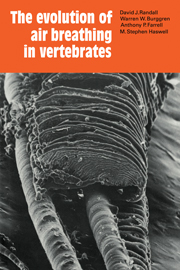Book contents
- Frontmatter
- Contents
- Preface
- 1 Introduction: air breathing in vertebrates
- 2 Gas transfer: the transition from water to air breathing
- 3 Ventilation and perfusion relationships
- 4 Mechanisms of ventilation
- 5 Regulation and control of gas transfer
- 6 The evolution of air breathing: a synthesis and summary
- References
- Index
6 - The evolution of air breathing: a synthesis and summary
Published online by Cambridge University Press: 01 March 2011
- Frontmatter
- Contents
- Preface
- 1 Introduction: air breathing in vertebrates
- 2 Gas transfer: the transition from water to air breathing
- 3 Ventilation and perfusion relationships
- 4 Mechanisms of ventilation
- 5 Regulation and control of gas transfer
- 6 The evolution of air breathing: a synthesis and summary
- References
- Index
Summary
We envisage that air-breathing vertebrates have evolved several times from water-breathing, bony fish belonging to the group Osteichthyes. These fish have within their body an enclosed chamber of air, which may function in buoyancy or as a source for oxygen. It is difficult to ascertain the evolutionary relationships between lungs and swim bladders, but they probably evolved independently, with lungs appearing before swim bladders. Because of their ventral location lungs have probably always functioned only in oxygen transfer, whereas dorsal swim bladders could function in either gas transfer or buoyancy control. These two functions are not mutually exclusive in swim bladders because the removal of oxygen without a simultaneous addition of an equal amount of CO2 to the gas chamber will reduce its size and result in an increase in the overall density of the fish. In all probability this dorsal gas bladder initially served both as an oxygen source during aquatic hypoxia, and for buoyancy regulation, depending on the nature of the environment and the requirements of the animal. Subsequent evolution in fish resulted in the development of some forms specialized for buoyancy control and others in which modifications for more efficient gas transfer were selected. The latter would have involved the elaboration of a large, thin respiratory epithelium and some means of ventilation and perfusion of this epithelium.
Modern-day bimodal breathers may use a modified gill, the buccal or pharyngeal cavity, a region of the gut, or a lung or gas bladder for gas exchange.
- Type
- Chapter
- Information
- The Evolution of Air Breathing in Vertebrates , pp. 115 - 119Publisher: Cambridge University PressPrint publication year: 1981



